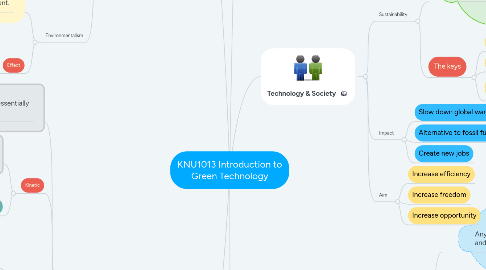
1. Natural Resources & Environmentalism
1.1. Scientific attribute of environment that are valued & have proven useful to human.
1.2. Natural resources
1.2.1. Flow
1.2.1.1. Non storable (Environemntal resource)
1.2.1.2. Storable
1.2.2. Fund
1.2.2.1. Renewable
1.2.2.1.1. Wind
1.2.2.1.2. Biomass
1.2.2.1.3. Geothermal
1.2.2.1.4. Water
1.2.2.2. Non-renewable
1.2.2.2.1. Non-recyclable
1.2.2.2.2. Recyclable
1.3. Environmentalism
1.3.1. Philosophy ideology, social movement that concern for environmental conservation & improvement of the health of environment.
1.3.2. Effect
1.3.2.1. Create environmental friendly society
1.3.2.2. Clean / healthy society
1.3.2.3. Knowledge for future generation
1.3.2.4. Less natural resource pollution
2. Energy & Environment
2.1. Energy
2.1.1. Total amount of work done E is essentially the integral of power P.
2.1.2. Kinetic
2.1.2.1. Used for doing a variety of work
2.1.2.2. E.g.
2.1.2.2.1. Electrical
2.1.2.2.2. Chemical
2.1.2.2.3. Thermal
2.1.3. Potential
2.1.3.1. Comes in forms that are stored
2.1.3.2. Include
2.1.3.2.1. Chemical
2.1.3.2.2. Gravitational
2.1.3.2.3. Mechanical
2.1.3.2.4. Nuclear
2.1.4. Industry
2.1.4.1. Responsible in
2.1.4.1.1. Energy generation
2.1.4.1.2. Energy supply
2.1.4.1.3. Energy usage
2.1.4.1.4. Application
2.2. Environment
2.2.1. Impact
2.2.1.1. Fossil fuels
2.2.1.1.1. Air pollution
2.2.1.1.2. Acid rain
2.2.1.1.3. Health
2.2.1.2. Nuclear
2.2.1.2.1. Waste steam
2.2.1.2.2. Radio active waste
2.2.1.2.3. Liquid, gas and solid waste
2.2.2. Solution
2.2.2.1. Decreasing the usage of conventional energy
2.2.2.2. Nuclear waste management
2.2.2.3. Replace conventional energy with renewable energy
3. Green Technology
3.1. Technology that prevent waste from generated in the environment and keeps resources moving in the material cycle
3.2. Goal
3.2.1. Sustainability
3.2.2. 'Cradle to cradle' design
3.2.3. Source reduction
3.2.4. Innovation
3.2.5. Viability
3.3. Areas
3.3.1. Energy
3.3.2. Construction
3.3.3. Green chemistry
3.4. Opportunity
3.4.1. Eco-friendly product & services
3.4.2. Jobs
3.4.3. Conserve resources
3.5. Challenges
3.5.1. Financing of recycling industries
3.5.2. Diverse stakeholder
3.5.3. Enabling policies
3.6. Ideas
3.6.1. Recycling e-Waste
3.6.2. Algae biofuel
3.6.3. Solar tower
4. Technology & Society
4.1. Sustainability
4.1.1. Planetary ecosystem consist of complex, dynamic and fragile network of interactions - some can be disrupted / damaged
4.1.2. The keys
4.1.2.1. Pursue alternative renewable sources
4.1.2.2. Recycle industrial waste
4.1.2.3. Production technique & product that use less energy & non-renewable sources
4.2. Impact
4.2.1. Slow down global warming
4.2.2. Alternative to fossil fuels
4.2.3. Create new jobs
4.3. Aim
4.3.1. Increase efficiency
4.3.2. Increase freedom
4.3.3. Increase opportunity
5. Energy from renewable sources (Sustainable energy strategy)
5.1. Renewable energy
5.1.1. Any form of primary energy from recurring and non-depleting indigenous resources.
5.1.2. Importance
5.1.2.1. Has potential to produce clean energy
5.1.2.2. Help reduce greenhouse effect
5.1.3. Types
5.1.3.1. Hydro-energy
5.1.3.1.1. Conversion of water flow to electricity
5.1.3.2. Solar energy
5.1.3.2.1. Radiant light and heat from the sun
5.1.3.3. Wind energy
5.1.3.3.1. Conversion of wind energy into useful form of energy
5.1.3.4. Biomass energy
5.1.3.4.1. Biological material derived from living or recently living organisms
5.1.3.4.2. Categories of material
5.1.3.5. Geothermal energy
5.1.3.5.1. Thermal energy generated & stored in Earth
5.1.4. Impact of RE
5.1.4.1. Job opportunity
5.1.4.2. New source of electricity generation
5.1.4.3. Clean environment
5.1.4.4. Reduce safety and healthy problem

